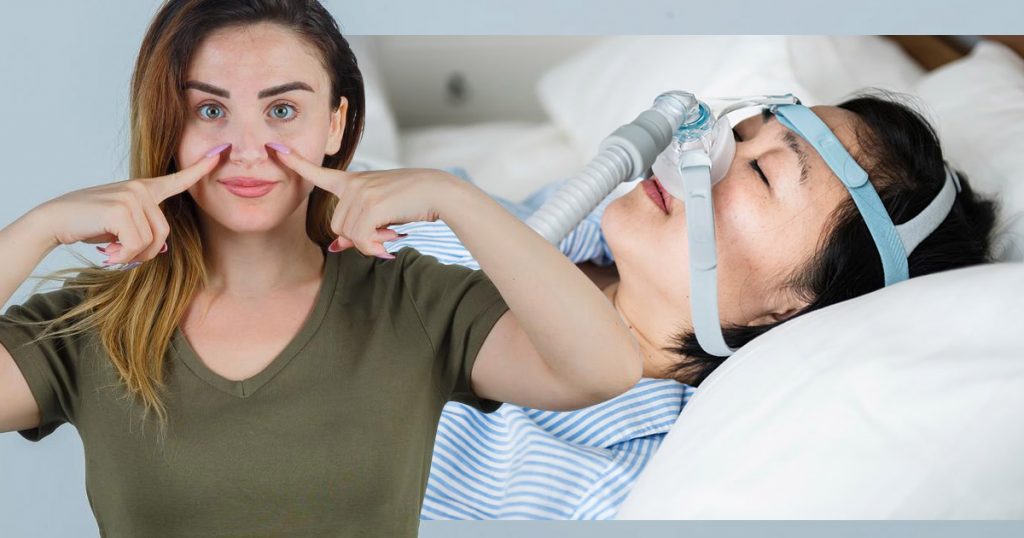Having a deviated septum can make getting a good night’s sleep more difficult than it should be. The shifted nasal wall can block airflow, leading to snoring, mouth breathing, and restless nights. In fact, a study using the Pittsburgh Sleep Quality Index found that individuals with a deviated septum scored significantly worse in all sleep quality parameters compared to those without nasal obstruction.
Sleep apnea is not directly caused by a deviated septum, but it can exacerbate its symptoms by limiting airflow and promoting mouth breathing, which may lead to sleep disruption. However, do not worry. With some simple adjustments and treatments, you can improve your sleep and start breathing easier.
Here’s how to make sleeping with a deviated septum more manageable, from choosing the right pillow to finding the best sleep position.
How to Sleep Better with a Deviated Septum
Sleeping with a deviated septum doesn’t have to feel like a nightly challenge. Small changes in your routine and sleep setup can make a big difference.
1. Elevate Your Head
Raising your head slightly while you sleep can reduce nasal congestion. When you’re lying flat, mucus tends to build up in your nasal passages, making it harder to breathe. Elevation allows better airflow and decreases blockage.
To do it, use a special pillow (like a wedge pillow) or stack a couple of pillows to keep your head raised throughout the night.
2. Use a Humidifier
Dry air can irritate your nasal passages, making symptoms worse. Adding moisture to the air with a humidifier keeps your nose hydrated and eases discomfort.
Try to run a humidifier in your bedroom, especially during winter or whenever your indoor air feels dry.
3. Try Nasal Strips and Sprays
Adhesive nasal strips can open up your nostrils by lifting the sides of your nose. Saline sprays, on the other hand, clear out mucus and soothe inflammation. Both options offer temporary relief and can be a lifesaver on particularly rough nights.
Best Pillow for a Deviated Septum
The pillow you use plays an important role in helping you breathe easier at night. Here are some good options to consider:
Wedge Pillows
These are perfect for keeping your head and upper body elevated. The angled design helps open your airways by reducing congestion caused by gravity.
Memory Foam Pillows
Memory foam pillows contour to your neck and head while giving you some height, making them a comfortable choice for sleeping with a deviated septum.
Adjustable Pillows
If you’re not sure what height works best, an adjustable pillow can be customized to the incline that feels right for you.
Using a supportive pillow not only reduces nasal blockages but can also limit snoring.
Best Sleep Position for a Deviated Septum
Your sleeping position can make or break your ability to breathe easily during the night.
1. Side Sleeping
Sleeping on your side is the best position for a deviated septum. This position encourages clearer airflow and reduces the pressure buildup in your nostrils. If one side of your nose feels more open, try sleeping on the opposite side to relieve the blockage.
2. Avoid Back Sleeping
Lying on your back can cause your tongue and throat tissues to fall back, worsening snoring and nasal obstructions.
3. Slightly Elevated Stomach Sleeping
Some people find sleeping on their stomach with a small tilt to the head can help. Just make sure your pillow supports your neck to avoid discomfort.
Does a Deviated Septum Cause Snoring?
Yes, it can! A deviated septum blocks nasal airflow, creating turbulence as you breathe. This turbulence causes tissues in your throat and nose to vibrate, resulting in snoring. While a deviated septum doesn’t directly lead to sleep apnea, it can worsen symptoms by encouraging mouth breathing and hindering airflow.
Can Fixing a Deviated Septum Help Sleep Apnea?
If your deviated septum is causing frequent nasal blockages, surgery may be the right choice for long-term relief. A procedure called septoplasty straightens your nasal wall to improve airflow. While fixing a deviated septum won’t cure sleep apnea entirely, it can reduce snoring and make treatments like CPAP (continuous positive airway pressure) therapy more effective and comfortable.
Many people who undergo septoplasty find breathing through their nose much easier, which also helps with sleep quality.
Other Helpful Tips for Better Sleep
A few extra tweaks to your routine and environment can go a long way in giving you a better night’s rest.
Keep Your Bedroom Clean
Dust and allergens can irritate your nasal passages. Regularly clean your room and change out bedding to minimize irritants.
Stay Hydrated
Drinking enough water during the day keeps mucus thin, which reduces nighttime congestion.
Avoid Alcohol Before Bed
Alcohol relaxes throat muscles, which can worsen snoring and make breathing harder.
Keep Cool Airflow
Use a fan or set your room temperature to keep the air slightly cool, as this can ease breathing, especially alongside humidity control.
Breathe Better, Sleep Better
Living with a deviated septum can be frustrating, especially at night. But with the right pillow, sleep position, and simple tools like humidifiers and nasal strips, you can create a sleep routine that works for you. When these adjustments aren’t enough, talk to an ENT specialist about more advanced treatments like septoplasty.
Good sleep shouldn’t feel impossible. Making minor yet significant adjustments will bring you one step closer to uninterrupted, restful sleep and mornings when you wake up feeling rejuvenated. Start these strategies tonight and breathe easy!
